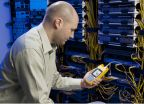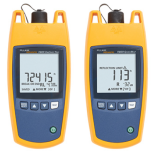Great Fiber Diagnostic Tool In Your Belt
June 16, 2016 / General, Installation and testing, Upgrading and troubleshooting, Best Practices
Maximizing productivity in today's fast-paced workplace is essential. Whether installing new fiber links or troubleshooting an existing network, the faster you can locate a problem, the faster you can fix it. That's easier said than done when you are faced with a complex network of fibers, connectors and patch cords.
A visual fault locator (VFL) is a great fiber diagnostic tool in your belt for verifying continuity and polarity and illum inating damaged connections, breaks, defective splices and tight fiber bends for exposed lengths of fiber in and around equipment racks. And while an Optical Time Domain Reflectometer (OTDR) is an indispensable tool for finding problems large or small along the entire cable length, it may be beyond the price range of someone who only occasionally needs to figure out where the fiber is broken.
inating damaged connections, breaks, defective splices and tight fiber bends for exposed lengths of fiber in and around equipment racks. And while an Optical Time Domain Reflectometer (OTDR) is an indispensable tool for finding problems large or small along the entire cable length, it may be beyond the price range of someone who only occasionally needs to figure out where the fiber is broken.
In other words, a VFL might not be enough and an OTDR might be too much. Like Goldilocks, sometimes you need something in between that's just right.
Filling the Gap
Let's say you've been called in to troubleshoot a lengthy singlemode fiber link that runs through a dense and complicated outside plant pathway system that is not easily accessible. You know the link is at least 8000 meters long, but you don't know the exact length or the location of the problem.
Your VFL won't do you much good since it's only capable of reaching a few miles and the cable isn't accessible anyway. Your team only has two expensive OTDRs that are being used elsewhere for compliance testing on a new install. What do you do?
Fluke Networks' Fiber OneShot™ PRO is the perfect tool to fill the gap between a VFL and an OTDR. This lightweight little tool measures the loss and reflectance of loss incidents and tells you exactly where they are located. And it maps all of the connections by showing the distance to up to nine events on links up to 23,000 meters, or 15 miles. And for multimode, the Fiber QuickMap™ works the same way up to 1,500 meters, or just under a mile.
Just Right

While Fiber OneShot PRO and Fiber QuickMap work like an OTDR in that they send light pulses though the fiber and measure the power and timing of light reflected from connections, splices, high loss incidents and the end of the fiber, they are much less complex -- and less costly.
With no complicated graphical trace analysis, the tools are an easy-to-use first response with intuitive one-button testing. Simply turn it on and connect your fiber to the connector on the unit (optional LC, ST and FT interchangeable adapters are available). Press TEST and in less than 6 seconds the display will show the loss and distance of the first incident detected. You can then press the up or down buttons to scroll through additional incidents.
Just like any fiber cable testing, launch and receive fibers will provide a view of the loss on the first and last connections of the link under test. A variety of launch and receive fibers are available, including UPC to APC for testing passive optical networks (PONs). And remember, cleaning all fiber connections is still a critical step -- the bulkhead connector on the tester, connectors on the launch and receive fibers and the connector on the cable under test should all be cleaned (a task that Goldilocks might neglect).
So whether the problem turns out to be a bad splice, severe bend, dirty connector of something a bit more uncommon like damage from a tree or one of the three bears, Fiber OneShot PRO and Fiber QuickMap give you that little something in between that's just right.




